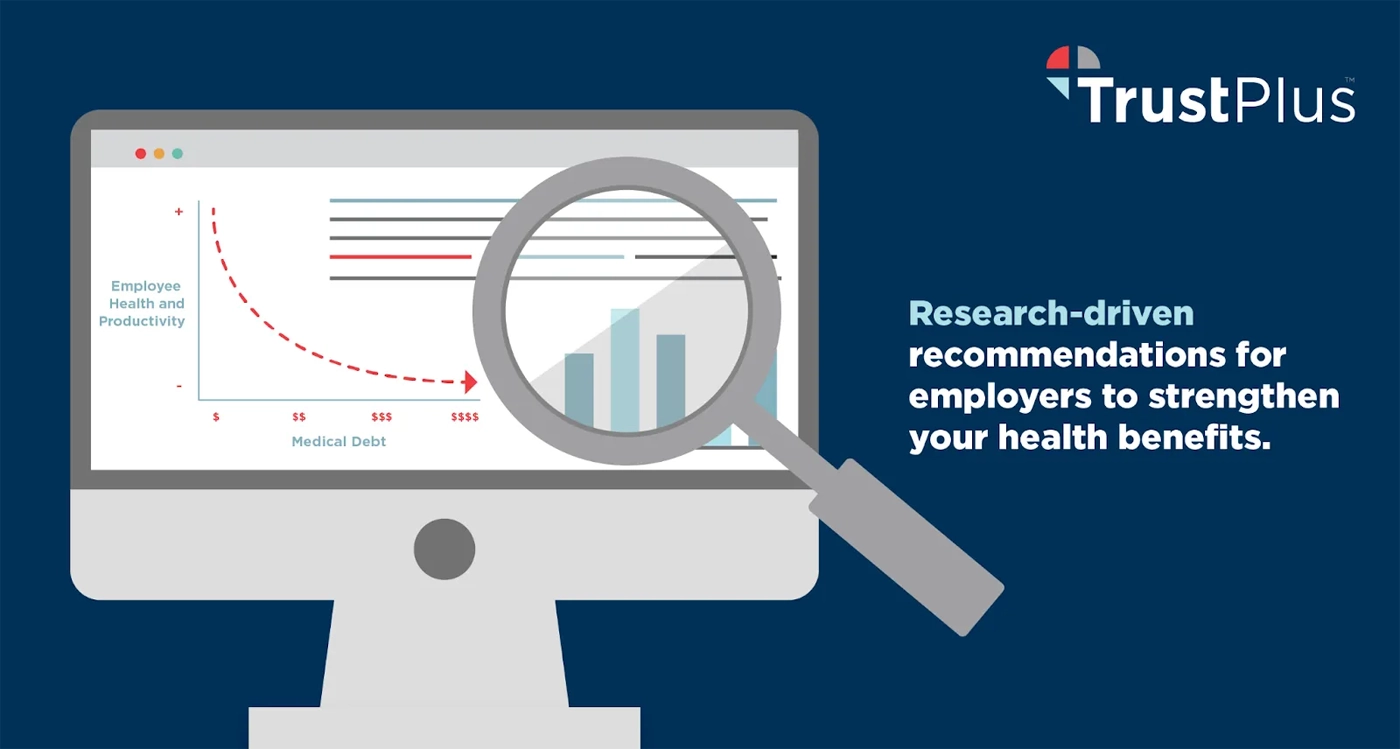New research from Neighborhood Trust informs five recommendations for employers to boost ROI on health benefits spending

Employers are uniquely positioned to help reduce workers’ medical debt—and as a result to help workers to improve their physical, mental and financial health—says new research from Neighborhood Trust Financial Partners (of which we, TrustPlus, are a service).
The fourth and final research brief in our partnership with Undue Medical Debt to address surging medical debt among lower-wage workers, “Solutions for Employers: How to Reduce Your Workers’ Medical Debt Burdens,” offers five research-informed recommendations for employers.
They build on our findings from surveys, qualitative interviews and a focus group with stakeholder experts, and comprise the top recommendations for employers to emerge from our research.
[For recommendations for hospitals, check out Undue Medical Debt’s complementary research.]
Boost financial health, reduce medical debt, on your budget
Every employer is different, with different workforces and different budgets. Knowing that not every recommendation is feasible for every employer, the following recommendations include varying levels of expected effort, cost and impact, which are detailed in full in the brief.
1. Investigate the specific healthcare needs of lower-income employees to choose plans that sufficiently meet those needs; and offer a transparent explanation of the selection process.
Your existing HR data is a useful asset. Start by examining aggregated personnel files to make informed decisions about likely healthcare coverage needs based on workers’ age range, where they live, genders, the prior year’s healthcare spending, etc. Who said analytics in HR is just a buzzword?!
A key point here relates to high deductible health plans.
If you are paying for premiums for HDHPs, “you may be inadvertently encouraging enrollment in plans that are likely the most expensive, worse option for lower-income workers.”
Consider reallocating those funds to more generously subsidize the premiums for plans with lower deductibles and more robust coverage.
Or, ensure that all employees to enroll in an HDHP not only have access to the information they need via a separate and additional training session, but also have a realistic and affordable means of building up a sufficient amount of savings in an HSA to cover their expected out-of-pocket costs (see recommendations #3 and #5).
2. Provide consistently available, free and confidential wraparound support for navigating the healthcare system.
Designate a company benefits subject matter expert to whom employees can reach out. Clarify when and where this person is available.
This person, an HR asset for your employees, might be Director of HR, or another staff member that receives training and has a direct line of communication with benefits providers for more complicated questions.
Whether you think of it as providing HR for employees or as sourcing an employer HR solution, designating an expert to be a human resource on these issues can be transformative for your workers and for your organization.
3. Invest in employees’ access to readily-available money for out-of-pocket healthcare spending via contributions into HSA/FSA accounts or access to a hardship fund, for example, given that most lower-income workers are managing thin cash flow margins.
Provide and contribute to paired HSA plans for all employees who enroll in HDHPs. When evaluating how much and in what cadence to contribute to plans, consider: are employees reaching a minimum of $500 in their accounts? If not: contribute more. Are they reaching at least $500 but not until November or December? If so, you may be contributing enough but should front-load the contribution earlier in the year so employees have a cushion to get started, which they can continue to build up with their own contributions.
4. Offer (and ideally subsidize) supplemental disability and accident insurance to protect income in the case of unexpected health needs and/or pregnancy-related costs, as lower-income employees are less likely to have savings to fall back on.
Assess whether employees would benefit from supplemental benefits and/or insurance products (such as disability or accident coverage) during evaluation process outlined in recommendation #1.
Decide whether it’s feasible to cover or offset the cost of supplemental benefits. Consider that subsidizing these benefits is likely an efficient use of funds because supplemental benefits may have an outsized impact on mitigating emergency room medical bills, for example, compared to increasing premium subsidies on healthcare plans.
5. Facilitate informed decision-making and increased cost predictability via year-round education and access to budgeting and health-savings self-service tools.
With the lowest cost to implement among our recommendations, and with medium effort expected to succeed, it should be one at which any leaders in search of small business HR solutions take a long look.
Health insurance alone is not enough
Employers of course cannot address medical debt alone.
We need a concerted effort from insurers, brokers, PEOs, employers, medical providers, and policymakers to tackle the root causes of today’s medical debt crisis to have meaningful long-term impact.
But our research shows that employers are indeed independently well-positioned to mitigate medical debt burdens in the near term, that making these improvements will help facilitate lower-income workers’ access to affordable healthcare without accruing burdensome medical debt, and that doing so is smart organizational leadership.
The recommendations address challenges and opportunities surfaced during previous phases of our research, including:
- Insurance alone is not enough for workers to avoid medical debt:
- 70% of survey respondents with healthcare coverage through their employer reported carrying medical debt.
- Medical debt impacts workers’ mental, financial, and physical health, largely due to deferred care.
- Workers are confused:
- Among those with insurance through their employer, 48% struggle to understand their health insurance coverage.
- Employers are uniquely situated to help (and to benefit from addressing medical debt among workers).
We heard again and again in interviews about the importance of getting information in the right “headspace” to retain it, which may not be during open enrollment.
Interviewees reported that they are frustrated by their limited visibility into their employers’ decision-making process around plan choice and contribution amounts.
And that they struggle with instability caused by employers changing their insurance provider every year.
The unpredictable nature of healthcare costs, exacerbated by poor communication around medical billing, also adds to workers’ stress.
Analytics in HR: Boost HR ROI on health benefits spending
By incorporating one or more of the recommendations into your healthcare-related HR practices, based on the analysis of your workers’ health needs, you can reduce medical debt burdens on your employees, and boost your health benefits ROI.
As “Solutions for Employers: How to Reduce Your Workers’ Medical Debt Burdens” concludes:
“These improvements will not only support employees’ financial, mental and physical well-being, but will also contribute to employers’ bottom lines via increased productivity and retention. When workers can comfortably afford their healthcare coverage without stress, and feel that their employer has their back in case of an emergency, they are more likely to feel positively about their job and feel engaged at work. And by allocating HR resources more effectively to address lower-income workers’ specific needs, employers can increase both the ROI and VOI of their healthcare spending.”
The VOI or value of investment is measured not by budget line items but by the qualitative impact on employees’ financial lives, personal lives, and workplace culture.
In other words:
“Investing in health-related benefits and worker financial health is a win-win for both employers and employees.”
Schedule a time with TrustPlus to discuss reducing your employees’ medical debt burdens to capture the benefits of a financially healthy workforce.






